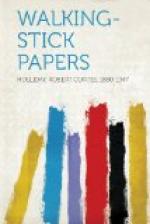Nature imitated art, indeed, when she designed William Gillette, remarkable fleshly incarnation of the literary figment, Sherlock Holmes. In the soul of Mr. Gillette, as on a stage, we witnessed a dramatic moral conflict. Two natures struggled before us within him. Which would prevail? Mr. Gillette was much interested in Rackham books. Bought a great many. In stock at this time was a very elaborate set in several quarto volumes of “Alice in Wonderland,” most ornately bound, with Rackham designs inlaid in levant of various colours in the rich purple levant binding. The illustrations within were a unique, collected set of the celebrated drawings made by various hands for this classic. The price, several hundred dollars. Mr. Gillette was torn with temptation here. And yet was it right for him to be so extravagant? Periodically he came in, impelled to inquire if the set had yet been sold. If somebody only would buy the set—why, then, of course—it would be all over.
In our contemplation of the literari we have amused ourselves with philosophic reflection. We recalled that old saw of Oscar Wilde’s (as George Moore says of something of Wordsworth’s) about the artist tending always to reproduce his own type. And we thought what an excellent model to the illustrator of his own “Married Life of the Frederic Carrolls” Jesse Lynch Williams would have been. No name itself, it struck us, would be happier for Mr. Williams than Frederic Carroll—if it were not Jesse Lynch Williams. A “colletch” chap alumnus. A typical, clever, exceedingly likable young American husband, fairly well to do: it is thus we behold him. Slender, in an English walking coat, smiling agreeably. One, we thought, you would think of as a popular figure in a younger “set.”
It is irrelevant, certainly, but we must acknowledge our indebtedness to a lady customer who supposed that the “Married Life of the Frederic Carrolls” was an historic work, dealing with the domestic existence of the author of “Alice.”
Thomas Nelson Page, autographing presentation copies of “A Coast of Bohemia,” remarks, “This is one of the rewards of poetry.” At this task, or, rather, pleasure, Mr. Page spent a good part of several successive days in the store. A gentleman, with a flavour of “the South” in his speech, very like his well-known pictures; stocky; an effect of not having, in length, much neck. Light, soft suit, or very becoming Prince Albert, and high hat. “He will wear you out,” whispers a colleague to us; “he has no idea where any of his friends live. I doubt if he knows where he lives himself.” The junior Mr. Weller, we recollect, when an inn “boots” referred to humankind in terms natural to his calling. “There’s a pair of Hessians in thirteen,” he said. Viewing Mr. Page with the eye of an attendant, we should remark that he is a Tartar. But a kindly, patient, courteous Tartar.




